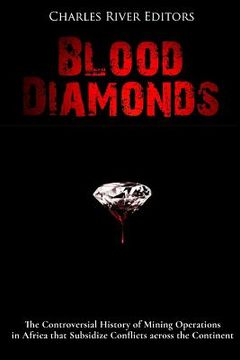Blood Diamonds: The Controversial History of Mining Operations in Africa that Subsidize Conflicts across the Continent (en Inglés)
Reseña del libro "Blood Diamonds: The Controversial History of Mining Operations in Africa that Subsidize Conflicts across the Continent (en Inglés)"
Sometime early in November 1985, a clandestine prison escape took place at the Plymouth County Correctional Facility in Massachusetts. With the usual prop of knotted together sheets, Charles Taylor an ex-Liberian government official, alumni student of Bentley College, Massachusetts, and fugitive from Liberian justice, scaled the wall and climbed into the rear passenger's seat of a car waiting to take him to New York. There, he was collected by his wife, Jewel Taylor, and spirited away. Thereafter, Charles Taylor slipped out of sight. The event attracted a few lines in the local press and a desultory police investigation but nothing more. Within a few weeks, the matter was closed and Charles Taylor was forgotten. Then, on Boxing Day 1989, BBC's Focus on Africa program aired an interview with Charles Taylor as he was somewhere in West Africa, announcing the commencement of a war. He spoke by satellite telephone, which at the time was the acme of modern communications, speaking with an identifiably American accent. His message was simply that his organization, the National Patriotic Front of Liberia-or the NPFL-had launched an invasion of Liberia with the purpose of overthrowing the current head of state, Master Sergeant Samuel Kanyon Doe. Thus began an improbable decade of anarchic and self-consuming violence that overwhelmed the tiny nation of Liberia and spread to neighboring Sierra Leone in one of the signature African civil conflicts of the late 20th century. It was during the Liberian and Sierra Leonean civil wars that the phenomenon of drug-addled and heavily-armed youth, many of them just children, were recruited and mobilized by local warlords against each other and the institutions of state and economy. It marked the beginning of television warfare, with the press following the conflict at every stage, documenting in excruciating detail the horror and violence of a thoroughly modern, budget revolution. The commercial exploitation of Sierra Leonean diamonds began in the early 1930s, in the Kono District in the east of the country. The first discoveries had been made by a British-held concern called Consolidated African Selection Trust, or CAST, in which a British shareholder body, Selection Trust Limited, shared a significant interest with the diamond giant De Beers. Transparency, of course, was not by any means absolute, but under British colonial oversight, the movement of diamonds out of the country was regulated and royalties channeled reasonably appropriately. In the past, all diamond mining in Sierra Leone had fallen under the control of the Sierra Leone Selection Trust-or SLST-a private investor body with exclusive rights to mine diamonds in Sierra Leone. By the mid-1950s and 1960s, illegal and illicit mining had taken over large areas of production. Figures vary, but by the 1960s, one can assume a figure of upwards of 100,000 illegal miners, both domestic and foreign, were active in the Kono District. Armed groups began to appear, challenging private SLST security, eventually fermenting a situation of anarchy under which regulated and taxed diamond production diminished to a trickle. Naturally, the corruption was at its most pervasive and creative surrounding diamonds. The industry was effectively criminalized, becoming the basis of a patrimonial shadow system geared toward sustaining wealth and power at its center. Distrustful of his own countrymen and tribal opponents, Stevens handed off much of the day to day business of diamonds to Lebanese businessmen who had been a somewhat anomalous presence in Sierra Leone since the end of the 19th century. From a peak of over two million carats officially exported in 1970, legitimate diamond exports dropped to 595,000 carats in 1980 and 48,000 carats in 1988.

